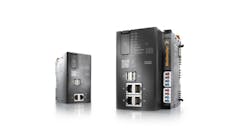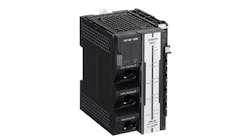|
C |
onsidering the highly developed nature of patent law
these days, most of the patents granted are likely to be truly legitimate. But with so many patents being granted (according toU.S. Dept. of Justice, Bureau of Justice Statistics, the number of patents granted has increased 197% from 62,000 annually in 1983 to 184,000 in 2001) for things not envisioned when the laws were devised (internet commerce and bio-engineered organisms to cite two examples) it&rsquos equally likely that there will be some that truly aren&rsquot, and that shouldn&rsquot have been granted in the first place. Many agree that this is true for Solaia&rsquos Patent 318.|
RELATED STORY Patent infringement case remains a tangled web |
Those with a thorough understanding, and a long enough history in the automation industry to understand the technology, maintain that as written, '318 won&rsquot hold up in court.
In a letter from a person identifying himself as an &ldquoindustry veteran who prefers to remain nameless,&rdquo (Start magazine &ldquoMail Call,&rdquo Jan. &rsquo03, p10) The '318 patent &ldquobasically patents a method for controlling a manufacturing operation using a spreadsheet add-on that talks directly to the registers in a programmable logic controller (PLC) without using the operating system or any I/O device.&rdquo He points out two big problems with '318: One, it&rsquos extremely narrow, and two, it had to be narrow to avoid a rejection based on a considerable amount of prior art&mdashsomething that anything patentable has to rise above to be granted.
Mr. Nameless offers a nicely succinct appraisal, and offers some truly insightful commentary on the patent&rsquos technical (or lack thereof) merits. He also points out the patent&rsquos real weakness&mdashthe amount of prior art that came before '318 was granted. But for a comprehensive analysis of the '318 patent on the record, the staff at High Tech Services (HTS), a North Carolina-based systems integrator provide a detailed appraisal on their website.
High Tech Services, founded by president by Keith Baldwin (who holds a Masters in integrated manufacturing systems and is a founding member of the CSIA) recommends that to better understand the problematic nature of the '318 patent it&rsquos instructional to understand what is patentable.
The U.S. patent office offers this: &ldquoIn the language of the statute, any person who ‘invents or discovers any new and usefulprocess, machine, manufacture, or composition of matter, or any new and usefulimprovement thereof, may obtain a patent,&rsquo subject to the conditions and requirements of the law. The word ‘process&rsquo is defined by law as a process, act or method, and primarily includes industrial or technical processes. The term ‘machine&rsquo used in the statute needs no explanation. The term ‘manufacture&rsquo refers to articles that are made, and includes all manufactured articles. The term &ldquocomposition of matter&rdquo relates to chemical compositions and may include mixtures of ingredients as well as new chemical compounds. These classes of subject matter taken together include practically everything that is made by man and the processes for making the products.&rdquo
The HTS analysis then quotes Roseman from the original patent application on a number of points but one stands out:
&ldquoThe invention furnishes a program or instruction means that operates through a general purpose spreadsheet program to effect information transfers to and from the addressable registers of a PLC and assigned cells of a displayed spreadsheet directly from the spreadsheet program and without transfers through the operating system program or a specially written device driver program.&rdquo
Says HTS, &ldquoWe don&rsquot see how using the specific words ‘PLC&rsquo or ‘spreadsheet&rsquo constitutes anything ‘new&rsquo or ‘improved.&rsquo &rdquo The systems integrator&rsquos analysis argues that &ldquoPLC&rdquo and &ldquospreadsheet&rdquo are nothing more than a type of computer and type of software that are communicating with each other.
&ldquoThere were other companies already making SCADA software that talked with PLCs at the time,&rdquo says HTS, and &ldquothat because computer programs were already talking to PLCs, uploading and downloading data, one might think that a claim about PLCs and spreadsheets would not hold up.&rdquo
A discussion of the prior art surrounding this patent continues in HTS&rsquos analysis: &ldquoBy 1987, not only were Modbus (Modicon) CCM (GE Fanuc), TIWAY (Texas Instruments), and DF (Allen-Bradley) in common use, high-speed networks such as Modbus Plus and Data Highway Plus were also in common use. There was obviously software for interfacing PLCs and many programs written. In our opinion, Mr. Roseman acknowledges all of this in his patent application.&rdquo
The discussion of prior art doesn&rsquot end there either. According to HTS, people were already reading and writing data to/from real-time controllers and PLCs using databases. &ldquoIn fact, our records show that we were using an IBM PC to read and write databases in factory automation in 1984. [And HTS] worked with a group at Texas Instruments in Johnson City, Tenn. in 1985 that developed a system tying manufacturing databases into automated lines, controlled by PLCs.&rdquo
Narrow and obsolete
A close examination of the '318 patent reveals that most, if not all of its discussion, as well as the drawings submitted, refer to Lotus&rsquo 1-2-3 spreadsheet program or a Lotus spread sheet cell. What HTS tries to carefully explain is that Roseman stresses the application of Lotus 1-2-3 @ functions to get PLC data directly to the spreadsheet. In his letter to the editor Mr. Nameless reminds everyone that prior to '318&rsquos writing &ldquoeven Lotus sold a product that was designed to control a manufacturing operation using a spreadsheet add-on running under DOS.&rdquo
High Tech Services summarized it all by saying Roseman used the Lotus development kit to write code that interfaced Lotus 1-2-3 to a Square D PLC. &ldquoIn our humble opinion, this is the only real claim that he can make&mdasha Square D PLC talking directly to Lotus 1-2-3 via @ functions.&rdquo Seems like a pretty narrow application.
High Tech Services&rsquo analysis points out that Lotus 1-2-3 is no longer around and that that alone should be enough to void the '318 patent. The analysis&rsquo writer points out that many tried the same thing in 1987 and rejected the idea as inferior to regular programs. &ldquoIn other words, we don't think using Lotus 1-2-3 to talk to PLCs is ‘useful&rsquo.&rdquo And says HTS, &ldquo15 years later hardly [anyone] uses a spreadsheet, much less Lotus 1-2-3 to interface to PLCs.&rdquo
High Tech Services maintains that other controllers and computer programs were already communicating with PLCs and other real-time controllers. &ldquoMr. Roseman refers to Microsoft's DDE specification in his patent application. Is this not showing prior art that Excel (a spreadsheet) and other software can use DDE to interface to PLCs? In our opinion, OPC is simply a new and improved version of DDE / OLE device drivers, which Mr. Roseman's invention disdains.&rdquo
Finally, HTS says there was other SCADA software already developed that talked with PLCs. &ldquoHow could Mr. Roseman talk to other types of PLCs without device drivers?&rdquo the company&rsquos spokesman asks. Wrapping it up with a bow, HTS declares: &ldquoMr. Roseman's invention was to interface Lotus 1-2-3 directly to a Square D PLC. We can understand&mdashbut do not agree with&mdasha claim against anyone using Lotus 1-2-3 to read and write [to] Square D PLCs. All other claims seem completely unjustified.&rdquo

Leaders relevant to this article:



